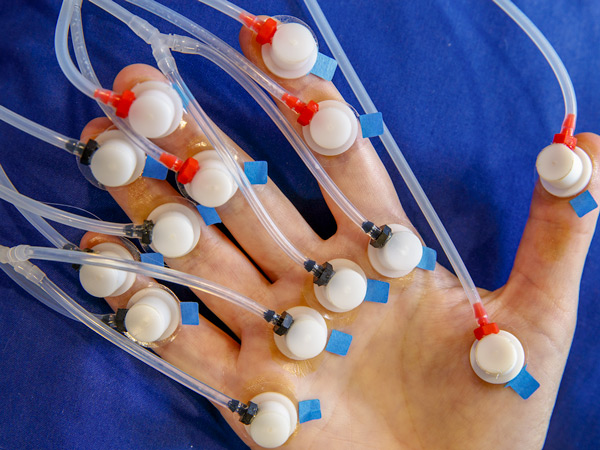up next Steven Barlow
Steven Barlow
Front-Line Stroke Care
Researchers Make Some Noise with a Silent Stroke Tool
April 2019
In the time it takes to read the few paragraphs of this story, somewhere in the U.S., a person will suffer a stroke. That’s roughly every 40 seconds. At the University of Nebraska—Lincoln, Steven Barlow’s research team is developing solutions for front-line treatment after a stroke. It’s all a question of blood flow.
One of the most common strokes is termed “ischemic stroke.” It obstructs blood flow to the brain, depriving it of the oxygen it needs to survive. Ischemic stroke is the leading cause of long-term disability and fifth-leading cause of death in the U.S.
“They have this phrase in the stroke literature, ‘time is brain.’ Every minute, you lose approximately 2 million neurons and 14 billion synapses as the stroke evolves,” said Barlow.

Using brain imaging, Barlow and his colleagues have found that their technology can increase brain blood flow up to 20 percent. In animal studies, it forced the brain to reroute blood supply to affected areas, to protecting the cells. Technically speaking, the science is a pTACS somatosensory stimulator, which is paired with a fixation device for functional transcranial Doppler ultrasound.
At first glance, the setup appears as complex as its name. There’s a headband that stretches across the wearer’s forehead, plus a spattering of white capsules stuck to their hands with clear plastic tubes sticking out. Pressurized air is pumped through the tubes, into the white capsules, and creates blood flow stimulus to the brain. As complicated as it looks, the treatment is non-invasive. And operationally silent. It’s a novel solution for a hectic emergency room, not the least because it could accelerate patient recovery from the get-go.
“It’s hard to overstate the impact this could have.”
The team is now partnered with CHI Immanuel Medical Center in Omaha to bring the technology to clinical trials with stroke patients. “When you think about the number of stroke victims, and it spans all ages, it’s hard to overstate the impact this could have,” said Barlow’s fellow researcher Greg Bashford.
And with the continued support of the University of Nebraska resources, one can only imagine the impact they’ll make.
Pictured in the header photo, from left to right: Doctoral student Jacob Greenwood, researchers Steven Barlow and Greg Bashford, doctoral students Ben Hage and Elizabeth Hoffman.
Discover our Podcast Series
The “Leading Nebraska” podcast shares the stories of the researchers, students, teachers and others across the University of Nebraska's four campuses who are making an impact. From teachers and doctors to engineers and ag experts, these Nebraska leaders are touching lives and making a difference.
Sorry, no stories match your filters.
Please adjust your filters above to view more stories.
Find Your Nebraska State Senator
Get started by entering your address below. Next, you'll receive information on who your senator is—and how to reach him or her.
Making a call only takes a few minutes and sends a strong message to your state senator. Your senator may not be able to take the call, but you can speak to the legislative aide who works for the senator. They will log your call, take a message and pass it on. Keep your conversation brief, and be sure to cover these essential points:
- Introduce yourself as a constituent in their district and provide your name.
- Be clear that you're calling about your support for the University of Nebraska System.
- Share your story about how the University has impacted you or your family. A personal story is hard to ignore. Explain why it's important to you that your senator invests in the University of Nebraska. Again, keep it brief and to-the-point.
- Ask for your opinion to be noted. Politely finish the call by thanking the senator or legislative aide for their time.
Send an Email
Sending a written message to your state senator is an easy way to engage your representative. They're more concise and easier to respond to, and they're more likely to be viewed by the senator. If you can, send a personalized message with these essential points. Keep your message brief (a paragraph or so).
- Write a personal, attention-getting subject line that lets the senator know your topic— "Investing in the University of Nebraska System" or "Supporting the University of Nebraska System"
- Introduce yourself as a constituent in their district; provide your name.
- Be clear that you're writing about your support for the University of Nebraska System
- Share your personal story about how the University has impacted you or your family. Explain why it's important to you that your senator invests in the University of Nebraska. Again, keep it brief and to-the-point.
- Ask if your senator will support the University moving forward.
- Indicate that you'd appreciate a reply and thank your senator for their time.
You Just Made a Difference
Keep making a difference by becoming an NU Advocate. As an Advocate, you'll receive communications about important issues and legislative bills concerning the University of Nebraska—and you'll be the first to hear about upcoming advocacy events. And, we'll let you know when you need to raise your voice again.
COOKIE USAGE:
The University of Nebraska System uses cookies to give you the best online experience. By clicking "I Agree" and/or continuing to use this website without adjusting your browser settings, you accept the use of cookies.

